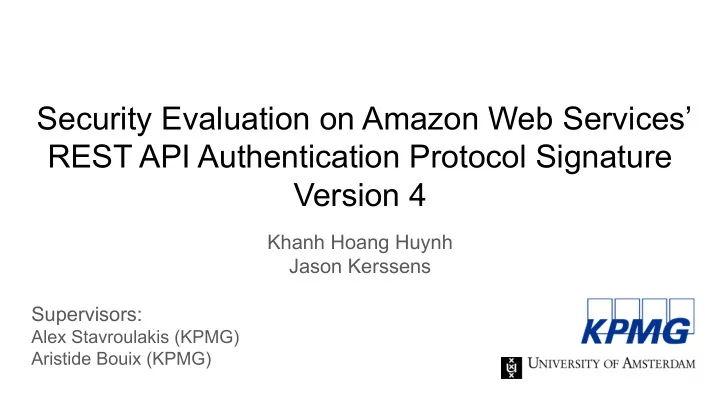

Security Evaluation on Amazon Web Services’ REST API Authentication Protocol Signature Version 4 Khanh Hoang Huynh Jason Kerssens Supervisors: Alex Stavroulakis (KPMG) Aristide Bouix (KPMG)
Introduction ● AWS As of 2018, AWS has a dominant share of 47.8% in the cloud service market 1 (IaaS, PaaS) ○ ● Signature Version 4 ○ Protocol used for authentication of HTTP API requests ○ Ensures data integrity, verification of the requesting user, and protection against reuse of signed requests ● Other protocols (different functionalities) do not provide end-to-end integrity ○ OAuth 1.0/2.0, SSL/TLS and HTTP Authentication 1 https://www.ciodive.com/news/iaas-Azure-AWS-Google-Cloud-Alibaba/559716/ 2
Research question Does the Signature Version 4 protocol, used when sending a request to AWS REST API endpoints, provide data integrity, verification of the requesting user, and protection against reuse of signed requests? ● How does Signatures Version 4 Protocol ensure data integrity, verification of the requesting user, and protection against reuse of signed requests? ● What kind of attacks are able to undermine data integrity, verification of the requesting user, or protection against reuse of signed requests? 3
Signature Version 4 ● Signing key is derived from the secret access key ● HMAC-SHA1 or HMAC-SHA256 ● The signature created is a string in hexadecimal and has a length of 64 4 Figure 1: Signature Version 4 signing procedure
Experiments ● Signature Version 4 makes use of HMAC-SHA ○ Attacks on HMAC-SHA are not feasible ● Replay Attack, Modifying Request, HTTP smuggling, and Timing Attacks ● As we look at Signature Version 4, we ignore SSL/TLS ● Attacks were first performed on our local server ● Attacks were then performed on AWS IAM and S3 services 5
Used Technologies ● Python ● Escher ● Burp Python Logo source: https://www.python.org/ Emarsys Logo (Escher Creator) source: https://www.emarsys.com/ Burp Suite logo source: https://portswigger.net/ 6
Replay Attack ● Protection against reuse of signed requests ● Intercept request and resend ● For how long? ● What kind of requests? Figure 2: The setup of our replay attack 7
Modifying the request ● Ensurance of data integrity ● Intercept request, modify it, and send it to intended destination ● What parts of the request can be modified? Figure 3: The setup of our modifying the request 8
HTTP Smuggling ● Verification of the requesting user ● Discrepancy in front-end server and back-end server Figure 4: The request flow of modern website architecture. Source: https://portswigger.net/ 9 Figure 5: Example of a HTTP request smuggling attack. Source: https://portswigger.net/
HTTP Smuggling Figure 6: The setup for HTTP smuggling attacks 10
Probing Timing Attack ● Verification of the requesting user ● Side-channel attack on Signature of HTTP request ● Measure execution time of request and response ● Correlation between execution time and number of valid bits ● Implementation dependent Example: ‘aaaa’ != ‘aaaa’ ‘aaaa’ != ‘aabb’ Figure 7: The setup of our Probing Timing attack 11
Probing Timing Attack Experiment in detail Figure 8: Flow of how we manipulated the signature Figure 9: An example of changing one bit of the correct signature 12
Results (replay attack) ● Replaying of requests possible ● Default valid for 15 mins for IAM ● X-AMZ-Expires option for S3 ● Prevented by SSL/TLS 13
14 Figure 10: HTTP Request and response
Figure 11: Replayed a HTTP Request and response 15
Results (modifying requests) ● Signed parts cannot be changed ● S3 unsigned payload option ● Prevented by SSL/TLS 16
Figure 12: HTTP request payload to be modified 17
Figure 13: HTTP request payload changed and sent 18
Figure 14: Successfully modified HTTP request and uploaded to AWS 19
Results (HTTP Smuggling) ● Not successful, as AWS responds with HTTP Status Code 500 Figure 15: Result of executing the detecting if http smuggling is possible 20
Results (Timing attack) ● Escher ● Correlation found? (between execution time and number of correct bits in signature) Figure 16: The results of seeing if a timing attack would be effective 21
Results (Timing attack) Figure 17: Figure 15, but without the standard deviation plotted 22
Conclusion How does Signature Version 4 ensure protection? ● Data integrity: Signature ● User verification: API KEY ID, and Secret Access Key ● Reuse of signed portions: Expiration of request What kind of attacks are possible? ● Replay attack: reuse of signed portions is possible for a limited time ● Modifying requests: signed portions of requests cannot be modified, unsigned portions can be modified ● HTTP Smuggling: not successful ● Timing attack: correlation found locally 23
Conclusion Does the Signature Version 4 protocol, used when sending a request to AWS REST API endpoints, provide data integrity, verification of the requesting user, and protection against reuse of signed requests? ● Provides data integrity of signed portions ● Verifies that signed parts were indeed signed by user ● Does not fully provide protection of reuse of signed portions 24
Future work ● Other services ● Timing attack on AWS servers ● Inspect the SSL/TLS from AWS API endpoint 25
Conclusion Does the Signature Version 4 protocol, used when sending a request to AWS REST API endpoints, provide data integrity, verification of the requesting user, and protection against reuse of signed requests? ● Provides data integrity of signed portions ● Verifies that signed parts were indeed signed by user ● Does not fully provide protection of reuse of signed portions 26
Recommend
More recommend